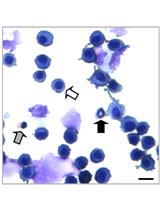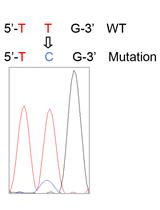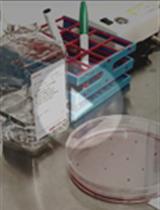- EN - English
- CN - 中文
Soft Agar Colony Formation Assay as a Hallmark of Carcinogenesis
软琼脂集落形成实验测定作为致癌性标志的集落形成
发布: 2017年06月20日第7卷第12期 DOI: 10.21769/BioProtoc.2351 浏览次数: 29517
评审: Antoine de MorreeVanesa Olivares-IllanaXiaoyi Zheng
Abstract
Soft agar colony formation assay is established to estimate the anchorage-independent growth ability of cells. In this assay, a bottom layer of agar with complete media is poured and solidified first, followed by an upper layer containing a specified number of cells suspended in medium-agar mixture. After two weeks of incubation, the number of colonies will be counted, serving as an indicator of malignancy of tumor cells.
Keywords: Anchorage-independent growth (非贴壁依赖性生长)Background
Anchorage-independent growth is an ability of cells to grow independently on a solid surface, and is considered as a hallmark of carcinogenesis (de Larco and Todaro, 1978). Soft agar colony formation assay is a well-established method to evaluate cellular anchorage-independent growth for the detection of the tumorigenic potential of malignant cells (Roberts et al., 1985), which is developed from plate colony formation assay described by Puck et al. in 1956 where cells were seeded on to a culture plate to assay the ability of cells to form colonies (Puck et al., 1956). The limitation of plate colony formation assay is that it only displays cellular abilities for anchorage-dependent growth, by which normal cells can escape from anoikis (a form of programmed cell death that occurs in anchorage-dependent cells when they detach from the surrounding extracellular matrix) and survive (Taddei et al., 2012). In contrast, malignant cells are capable of proliferating and growing without attachment to a substrate. Therefore, soft agar colony formation assay is developed to characterize this ability in vitro (Hamburger and Salmon, 1977; Yuan et al., 2017). The soft agar colony formation assay has been widely adapted for researches on cell differentiation, transformation and tumorigenesis as well as the efficacy evaluation of anti-tumor treatment.
Materials and Reagents
- Cell culture disc (75-cm2) (Corning, catalog number: 430641 )
- Cell culture plate (12-well) (Corning, Costar®, catalog number: 3513 )
- Falcon 15 ml conical centrifuge tubes (Corning, catalog number: 430791 )
- Counting slides (Bio-Rad Laboratories, catalog number: 1450011 )
- 0.1-20 ml volume pipette tips (Eppendorf, catalog number: 22492012 )
- 5-200 ml volume pipette tips (Eppendorf, catalog number: 22492039 )
- 50-1,000 ml volume pipette tips (Eppendorf, catalog number: 22492055 )
- Human SGC7901 cell line (Cell Resource Center of the Chinese Academy of Sciences, catalog number: CC-Y1456 )
- Phosphate buffered saline (PBS) pH 7.4 (Thermo Fisher Scientific, GibcoTM, catalog number: C10010500BT )
- Trypsin-EDTA (0.25%) (Thermo Fisher Scientific, GibcoTM, catalog number: 25200072 )
- RPMI 1640 medium (Thermo Fisher Scientific, GibcoTM, catalog number: C11875500BT )
- Fetal bovine serum (Thermo Fisher Scientific, GibcoTM, catalog number: 10099141 )
- Penicillin-streptomycin (5,000 U/ml) (Thermo Fisher Scientific, GibcoTM, catalog number: 15070063 )
- L-glutamine (Thermo Fisher Scientific, GibcoTM, catalog number: 25030081 )
- Agar (Biowest, catalog number: 111860 )
- Complete 1640 medium (see Recipes)
- 5% agar solution (see Recipes)
Equipment
- 2-20 μl pipettes (Thermo Fisher Scientific, Thermo ScientificTM, catalog number: 4641060N )
- 20-200 μl pipettes (Thermo Fisher Scientific, Thermo ScientificTM, catalog number: 4641080N )
- 100-1,000 μl pipettes (Thermo Fisher Scientific, Thermo ScientificTM, catalog number: 4641100N )
- Clean bench (Thermo Fisher Scientific, Thermo ScientificTM, model: HeraguardTM ECO )
- Autoclave (TOMY DIGITAL BIOLOGY, model: SX-500 )
- Water-Jacketed CO2 incubators (Thermo Fisher Scientific, Thermo ScientificTM, model: FormaTM Series II 3110 , catalog number: 3131)
- Thermostat water bath (Prima Technology, model: YB12 )
- Centrifuge (Eppendorf, model: 5424 R )
- Automated cell counter (Bio-Rad Laboratories, model: TC20TM )
- Advanced microscopy group microscope (Thermo Fisher Scientific, model: EVOS )
- Gel count colony counter (Oxford optronix, model: GelCountTM )
Software
- Statistical Program for Social Sciences 17.0 software (SPSS)
Procedure
文章信息
版权信息
© 2017 The Authors; exclusive licensee Bio-protocol LLC.
如何引用
Readers should cite both the Bio-protocol article and the original research article where this protocol was used:
- Du, F., Zhao, X. and Fan, D. (2017). Soft Agar Colony Formation Assay as a Hallmark of Carcinogenesis. Bio-protocol 7(12): e2351. DOI: 10.21769/BioProtoc.2351.
- Zhao, X. D., Lu, Y. Y., Guo, H., Xie, H. H., He, L. J., Shen, G. F., Zhou, J. F., Li, T., Hu, S. J., Zhou, L., Han, Y. N., Liang, S. L., Wang, X., Wu, K. C., Shi, Y. Q., Nie, Y. Z. and Fan, D. M. (2015). MicroRNA-7/NF-kappaB signaling regulatory feedback circuit regulates gastric carcinogenesis. J Cell Biol 210(4): 613-627.
分类
癌症生物学 > 通用技术 > 细胞生物学试验
细胞生物学 > 基于细胞的分析方法 > 集落形成
您对这篇实验方法有问题吗?
在此处发布您的问题,我们将邀请本文作者来回答。同时,我们会将您的问题发布到Bio-protocol Exchange,以便寻求社区成员的帮助。
提问指南
+ 问题描述
写下详细的问题描述,包括所有有助于他人回答您问题的信息(例如实验过程、条件和相关图像等)。
Share
Bluesky
X
Copy link












